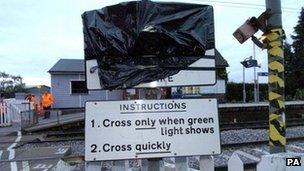Network Rail fined £1m over girls' level crossing deaths
- Published

Charlotte Thompson and Olivia Bazlinton were killed on 3 December 2005
Network Rail has been fined £1m after admitting health and safety breaches over the deaths of two girls at an Essex level crossing.
Friends Olivia Bazlinton, 14, and Charlotte Thompson, 13, were hit by a train in December 2005 as they crossed the railway line at Elsenham station and died instantly.
The company pleaded guilty to three offences at Chelmsford Crown Court.
Judge David Turner QC also ordered Network Rail to pay £60,000 costs.
A series of risk assessments had been carried out at the site, which highlighted the dangers of the crossing. A Network Rail report from 2002 had recommended new gates that locked automatically as trains approached but they had not been fitted.
'Took our daughters'
Olivia's father Chris Bazlinton said: "The process of justice has been done and they have been fined £1m - it is nothing more than symbolic.
"I still think we have got to go on and ask who knew what and when? I want something to be done about it.
"I believe there was a cover up. Why did the three most important documents (in the case) only turn up in the last 12 months?"
Hilary Thompson, Charlotte's mother, said: "They took our daughters from us and they broke our hearts."
Charlotte's father, Reg Thompson, added: "What Network Rail have promised to do today in court, which is to spend £130m on improving safety on level crossings, and the changes that they have already made, have come about because of the terrible thing that happened to our daughters."
'Tragic case'
Judge Turner accused Network Rail of "corporate blindness". He said: "The company unreservedly apologises for its failures which contributed to the deaths of these young girls.
"Network Rail, in part by itself and in part through its predecessor Railtrack, failed to ensure that the risks were properly assessed, controlled or managed.
"The company concedes that the procedures or standards in place for conducting level crossing risk assessments before 2005 were deficient."
Following the sentence Network Rail chief executive Sir David Higgins said: "On behalf of Network Rail I apologise for the mistakes made by us in this tragic case that contributed to the deaths of Olivia and Charlotte.

The girls were killed at Elsenham railway station in December 2005
"Nothing we can say or do will lessen the pain felt by Olivia and Charlotte's families but I have promised the families that we will make level crossings safer, and we will deliver on that promise.
"Fundamental changes to the way we manage and look after the country's 6,500 level crossings have, and are being made.
"In recent years we have reassessed all of our crossings and closed over 500. There is still much to do and we are committed to doing what is necessary to improve our level crossings."
The mothers of the girls sat next to each other in court cradling old teddy bears.
They listened as prosecutor Jonathan Ashley-Norman described the moments leading up to the incident on 3 December 2005.
Mr Ashley-Norman said: "This is as tragic a case as any to reach the criminal courts."
Unlocked gates
The court was told the girls were looking forward to a day out together in Cambridge when tragedy struck.
Mr Ashley-Norman said: "While the lights were still flashing, but plainly believing themselves safe to cross, they stepped across the track and directly into the path of the train heading in the opposite direction.
"They were instantly killed."
The girls died as they crossed the footpath leading to Elsenham station platform. The crossing was fitted with warning lights and yodel alarms.
A London to Cambridge train passed over the crossing with the red lights and yodel sounding - a warning for foot passengers not to cross.
After the train passed, the lights remained on and the alarms continued to sound as another train, travelling from Birmingham to Stansted Airport in Essex, was going to pass through the station.
The girls opened the unlocked wicket gates and walked on to the crossing. They were both struck by the Stansted train and killed.
In January, Network Rail, the authority responsible for the UK's railway network, admitted breaching health and safety laws at the level crossing.
Mr Ashley-Norman told the court the lateness of the prosecution came as a result of "serious flaws in the disclosure process" from Network Rail.
'Undesirably risky'
Key risk assessment documents did not come to light until the bereaved families pursued civil action against the authority, he said.
"Once the full chronology was revealed, serious failures in the approach to the assessment of risk at Elsenham were exposed," he said.
Mr Ashley-Norman told the court about a series of risk assessments that were performed by the company in the years leading up to the accident.
One which was conducted in May 2001 called the wicket-gate pedestrian crossing "undesirably risky".
The assessment, conducted by John Hudd, East Anglia level crossings manager for Network Rail, reads: "I have quite serious reservations about the arrangements which are in place for pedestrians.
"The combination of free pedestrian wickets adjacent to locked vehicular gates with a crossing keeper on hand is not very comprehensible to the layman (or me!).
"What makes the whole thing I believe undesirable risky is the large numbers of users (which includes a lot of schoolchildren)."
- Published31 January 2012
- Published31 January 2012
- Published25 November 2011
- Published14 February 2011
- Published12 February 2011